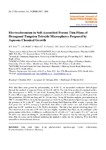Electrochromism in Self-Assembled Porous Thin Films of Hexagonal Tungsten Trioxide Microspheres Prepared by Aqueous Chemical Growth

View/
Date
2014-03Author
Sone, B.T.
Mailu, S.N.
Malwela, T.
Coetsee, E.
Swart, H.C.
Iwuoha, E.I.
Maaza, M.
Metadata
Show full item recordAbstract
WO3 thin films were grown by self-assembly, at 80-90 ˚C, on un-seeded conductive SnO2:F-glass through the method of Aqueous Chemical Growth (ACG). The thin films produced contained urchin-like microspheres of WO3, 1-2 μm thick. Scanning Electron Microscopy (SEM) and Transmission Electron Microscopy showed these microspheres to consist of a thick central core on which grew hair-like protrusions 200-400 nm long and 50-100 nm wide. X-ray Diffraction analysis, post annealing at 500 ˚C, revealed WO3 to be in the hexagonal phase while X-ray Photoelectron Spectroscopy confirmed the presence of W in the W6+ state. Focused Ion Beam-Field Emission SEM revealed a porous thin film grown for 18-24 h, averagely 3 μm thick, that offers a wide surface area and shorter diffusion path-ways for H+ insertion in a 0.1M H2SO4 electrolyte. The fairly fast optical switching times (15-25s) observed at a scan rate of 50 mV/s for such highly crystalline thin films can be attributed to the porous nature of the films. A diffusion coefficient for H+ of 1.66 x 10-11 cm2/s and 1.33 x 10-11 cm2/s at 50 mV/s was observed during H+ insertion/de-insertion. We propose that by reducing film growth time, film thickness can be reduced rendering the method a viable one for producing WO3 thin films amenable to electrochromic devices.
